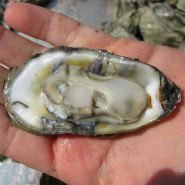MOREHEAD CITY – Pull out the fire grates, steamer pots and shucking knives: Oyster season begins Thursday.

To keep this oyster season healthy and happy, the N.C. Department of Environmental Quality, Division of Marine Fisheries offers the following advice for consumers and fishermen.
Supporter Spotlight
For those who eat ’em
Consumers need to take some common sense precautions when buying, storing and preparing oysters and clams to prevent illnesses caused by two environmental bacteria.
Vibrio vulnificus and Vibrio parahaemolyticus are common, naturally occurring bacteria found in coastal waters worldwide and are most abundant when water temperatures are warm. In rare instances, these bacteria can cause serious gastrointestinal illnesses or wound infections.
During the past several years, the Centers for Disease Control and Prevention have reported an increase in Vibrio infections across the United States. People with compromised immune systems are most at risk, particularly for the more serious illnesses caused by Vibrio vulnificus. However, everyone is susceptible to less severe illness caused by pathogenic strains of Vibrio parahaemolyticus.
Before they indulge, consumers should remember these tips from the N.C. Division of Marine Fisheries’ Shellfish Sanitation and Recreational Water Quality Section:
Thorough cooking destroys these naturally occurring bacteria. Those with the following conditions are at higher risk for illness from raw or undercooked oysters and clams and are advised to fully cook all shellfish:
Supporter Spotlight
– Liver disease (from hepatitis, cirrhosis, alcoholism or cancer)
– Diabetes
– Iron overload disease (Hemochromatosis)
– Cancer (including lymphoma, leukemia, Hodgkin’s disease)
– Stomach disorders
– Any illness or medical treatment that weakens the body’s immune system. If you are unsure of your risk, ask your doctor.
Only purchase oysters and clams from reputable dealers, retailers, grocers, markets or restaurants. It is illegal for shellfish harvesters to sell directly to the public without a dealer license and certified facility. These facilities are regulated to ensure sanitation and temperature control is maintained on the shellfish.
By law, the shellfish tag must be removed by the vendor at the last point of sale. However, you may ask to see the tag to ensure you are receiving a fresh product. For the best quality, shellfish should be consumed within 10 days of being harvested. If properly refrigerated, they are still safe to eat and will last longer, but the quality will start to diminish.
Keep oysters and clams refrigerated at 45 degrees or below until you are ready to prepare them. The bacteria commonly found in shellfish can multiply rapidly if they are left exposed to air temperatures above 50 degrees.
Thoroughly wash shellfish prior to cooking. Remove all mud and dirt from the shell using water and a stiff brush. Many dealers will wash oysters for a nominal fee when you purchase them. The mud and dirt may contain bacteria so it is important to clean the shellfish prior to serving or cooking.
Prior to cooking or raw consumption, discard any dead shellfish. Dead shellfish will have slightly gaping shells that will not close when tapped.
For those who shuck ‘em
The N.C. Division of Marine Fisheries provides the public with drop-off sites for recycling oyster shells. Recycled shells are put back into the waters, where they serve as habitat for future oysters and a multitude of other small marine organisms that fish eat.
For those who harvest ’em
Harvest of oysters by hand methods from public bottom begins at sunrise Oct. 15.
Those who hold proper commercial fishing licenses may harvest oysters from sunrise to sunset Monday through Friday each week. Commercial harvest limits are different for some waters, and fishermen should see Proclamation SF-6-2015 for specific regulations.
Recreational hand harvest is allowed sunrise to sunset seven days a week. The harvest limit is one bushel of oysters per person per day or two bushels per vessel per day if more than one person is on a boat. No license is required for recreational harvest, but the oysters may not be sold.
The minimum size limit is 3 inches shell length.
Some waters are still temporarily closed to shellfish harvesting due to high bacteria levels associated with the recent runoff and flooding. Fishermen should check for shellfish closures. Fishermen should continue to frequently check for closures throughout the year, particularly after heavy rainfalls. They may also call the N.C. Division of Marine Fisheries at 252-726-7021 or 1-800-682-2632 to check for closures.
For more information
– About Vibrios, see the N.C. Department of Health and Human Services’ website.
– About shellfish safety, contact Patti Fowler, the division’s Shellfish Sanitation and Recreational Water Quality section chief, at 252-808-8147 or Patti.Fowler@ncdenr.gov. You may also contact Shannon Jenkins, with the Shellfish Sanitation Section, at 252-808-8148 or Shannon.Jenkins@ncdenr.gov.
– About this year’s oyster season, contact Trish Murphey, the division’s Southern District manager, at 252-808-8091 or Trish.Murphey@ncdenr.gov or Tina Moore, also with the division, at 252-808-8082 or Tina.Moore@ncdenr.gov.







